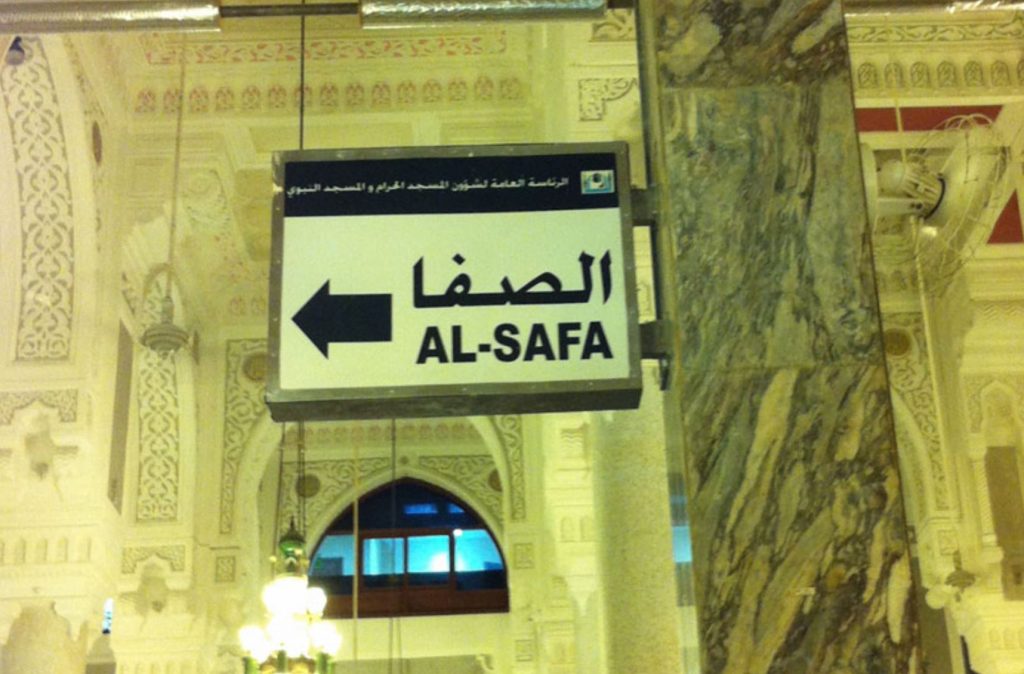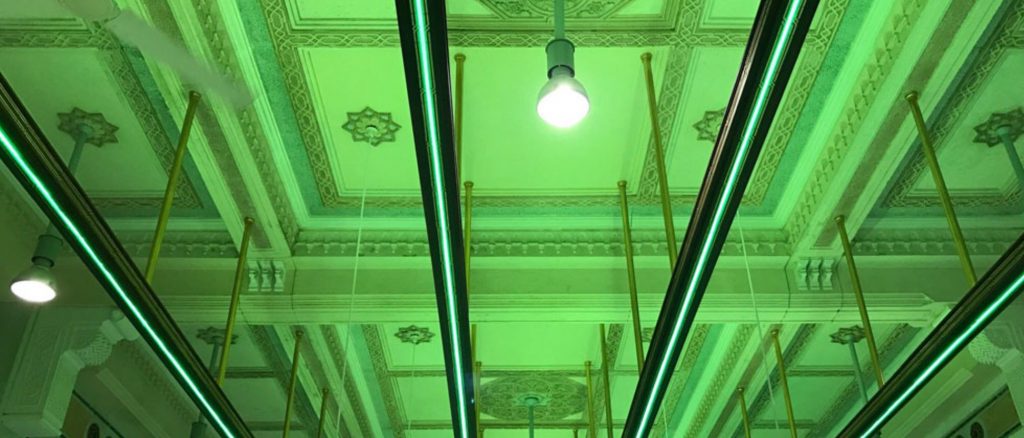The act of Sa’i is an essential component of Umra. It involves walking seven times between the hills of Safa and Marwah. It is recommended to perform Sa’i immediately after Tawwaf, but taking a break if needed is acceptable. If you feel exhausted or have sore feet after Tawwaf, it’s okay to take a pause in the pavilion until you feel ready. Keep in mind that Sa’i involves covering more than three kilometers, so make sure you have enough energy before starting.
Before beginning Sa’i, it is customary to perform Istilam of Hajar al-Aswad one final time, for a total of nine times (including the eight performed during Tawwaf). If, for some reason, you were unable to perform the ninth Istilam at the Hajar al-Aswad or you are too tired to reach it, you may omit it, but you can perform Istilam at any other location in the Masjid al-Haram as long as you are facing the Hajar al-Aswad.
Proceed to the hill of Safa, which is located in line with the Hajar al-Aswad. There is a white sign which indicates where it is. As you’re approaching Safa, it is Sunnah to recite the following:
ِإِنَّ الصَّفَا وَالْمَرْوَةَ مِن شَعَائِرِ اللَّهِ
Inna ṣ-ṣafā wa l-marwata min sha’ā’iri llāh(i).
Indeed, Safa and Marwa are from the Signs of Allah.
[Surah al-Baqarah, 2:158]
Then say:
أَبْدَأُ بِمَا بَدَأَ اللهُ بِهِ
Abda’u bimā bad’allahu bihi.
I begin with that which Allah has begun with.
At Safa Hill, turn towards the Ka’abah and raise your hands in prayer. Even though the Ka’abah may not be visible, make a rough estimation of its location and face that direction. Don’t raise your hands to your earlobes or make any gestures towards the Ka’abah as you did during Tawwaf. You can say “Allāhu akbar” and “lā ilāha illā Allāh,” and offer blessings to the Prophet ﷺ. Reciting the following Dua is recommended.

اَللّٰهُ أَكْبَرُ، اَللّٰهُ أَكْبَرُ، اَللّٰهُ أَكْبَرُ، وَلِلّٰهِ الْحَمْدُ
Allāhu akbar, Allāhu akbar, Allāhu akbar, wa lillāhi l-ḥamd.
Allah is the greatest; Allah is the greatest; Allah is the greatest, and to Allah belongs all praise.
لاَ إِلَهَ إِلاَّ اللَّهُ وَحْدَهُ لاَ شَرِيكَ لَهُ، لَهُ الْمُلْكُ وَلَهُ الْحَمْدُ يُحْيِي وَيُمِيتُ، وَهُوَ عَلَى كُلِّ شَيْءٍ قَدِيرٌ
Lā ilāha illallāh waḥdahu lā sharīka lah(u), lahu l-mulku wa lahu l-ḥamdu yuḥyī wa yumīt(u), wa huwa ‘alā kulli shay’in qadīr.
There is no deity except Allah, alone without a partner. To Him belongs the Dominion, and to Him belongs all praise. He gives life and death and He has power over everything.
لَا إِلَهَ إِلَّا اَللَّهُ وَحْدَهُ، اَنْجَزَ وَعْدَهُ وَنَصَرَ عَبْدَهُ وَهَزَمَ اَلْأَحْزَابَ وَحْدَهُ
Lā ilāha illallāhu waḥdah(u), anjaza wa’dahu wa naṣara ‘abdahu wa hazama l-aḥzāba waḥdah.
There is no deity except Allah alone. He fulfilled His promise, supported His slave and defeated the confederates alone.
After reciting this Dua, you may recite your own supplications. Read the Dua a total of three times, making your own supplications in between each time, as was the Sunnah of the Prophet ﷺ.
From Safa, make your way towards Marwa. Between Safa and Marwa, you will encounter two sets of green fluorescent lights approximately 50 metres apart, which indicate the distance that Hajar ran in order to get to higher ground. These two markers are known as Milayn al-Akhdharayn (the two green mileposts). Between these two lights, it is Sunnah for men to run at a medium pace while women should continue normally.

There is no fixed Dhikr or Dua that has been prescribed to be read during Sa’i, so you may recite any prayers or supplications of your choice and send Salawat upon the Prophet ﷺ.
Upon reaching the hill of Marwa, face the direction of the Ka’abah, raise your hands in supplication and repeat the same supplications you recited at Safa.
This completes one lap of Sa’i. Returning back to Safa is considered a second lap.
Repeat this procedure until you have completed seven laps, at which point you should be at the hill of Marwa.
Final Step: Haliq or Taqsir.